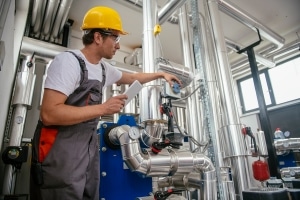
Heat Supply Systems
Planning of modern heat supply systems
For the use of almost every building a technical building equipment (TGA) is necessary. This includes sanitary engineering, lighting, air conditioning, ventilation, elevator and conveyor technology, measurement and control technology and building automation. These and a number of other areas are combined under the term supply engineering, which also includes heat supply systems.
What is meant by heat supply systems?
Although it is actually obvious to equate the term heat supply systems with the term heating, this is not quite correct, because heat supply systems are much more complex and do not only cover the heating of buildings. In most cases, the heat supply is combined with the provision of hot domestic water, and thus also affects the field of sanitary engineering.
Basically, heat supply comprises 3 sub-areas:
- Heat generation
- Heat distribution
- Heat transfer
Heat generation
The heat is either generated decentrally, from outside the building in heating plants and supplied to the building as district heating through insulated pipes, or it is generated in the building itself by a central heating system. A central position is occupied by combined heat and power plants, which provide both electricity and heat for several neighbouring buildings or a building complex.
Recently, solar thermal systems and heat pumps have also been gaining in importance as facilities for central heat generation. In the majority of cases, they supplement the classic heat generation systems, but are not used exclusively for heat generation.
Heat distribution
This refers to a system of pipes, valves, regulators and measuring and control equipment whose task is to distribute the heat generated during heat generation throughout the building. In most cases, insulated pipelines are used for this purpose, which are an integral part of the building services engineering.
Heated water is used as a means of transporting the heat because it is more suitable for this purpose than almost any other medium. Water is inexpensive, available almost everywhere and can store large amounts of heat.
Technically, hot water is easy to control and less susceptible to faults than other storage media, for example steam. In the field of heat distribution, the sub-areas of heat supply, sanitary engineering and measurement and control technology interpenetrate. Part of the hot water is not used for heating, but for the provision of hot service water.
Heat transfer
This area of heat supply systems has the task of transferring the heat generated in the heat generation systems and delivered to the interior of the building through heat distribution to the spatial surroundings, in order to create a pleasant living or working climate. Radiators, the last link in the chain of heat supply, are used for heat transfer. Three basic physical principles are used to transfer heat:
- Convection
- Heat radiation
- Heat conduction
Radiators mainly use a combination of convection and thermal radiation to transfer heat. In convection, the radiator gives off its heat to a medium in its environment; the room air. This air is heated and expands.
The environment is not heated. Since it is lighter than cold air, a cycle begins that distributes the heat evenly throughout the room. Heat radiation, on the other hand, is infrared rays that emanate from the radiator and directly heat the object they hit. The environment is not heated.
Heat radiation has an immediate effect and is perceived as natural and pleasant because it technically implements the principle of solar heat. Heat conduction, on the other hand, plays a more important role in heat generation and heat distribution. Heat conduction means the direct transfer of heat from one material to another, for example heating water in boiler plants.
Summary
Modern heat supply systems are complex systems in which different processes are used to generate and distribute heat. Often several processes are combined. When planning heat supply systems, costs, efficiency and environmental friendliness play a major role. As far as it is technically possible, the client’s wishes are taken into account.



